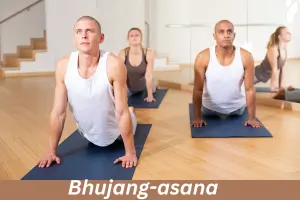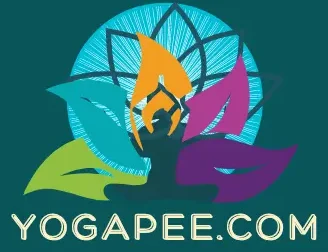
Introduction
Bhujangasana, commonly known as the Cobra Pose yoga, is a foundational yoga asana that offers numerous physical and mental benefits.
Derived from the Sanskrit words “Bhujanga” meaning serpent and “Asana” meaning posture, the pose resembles a cobra with its hood raised.
Types of Bhujangasana
- Saral Hasta Bhujangasana (Cobra Pose yoga)
This is the traditional form of Bhujangasana, where the head and upper torso are raised like a cobra’s hood. This variation has special significance in Hatha Yoga as it positively impacts many bodily systems and is excellent for overall health. - Vakra Hasta Bhujangasana (Curved Hands Cobra Pose yoga)
This variation focuses on enhancing digestion by modifying the arm position, which creates a deeper stretch in the abdomen and digestive organs. - Ardha Bhujangasana (Half Cobra Pose yoga)
Also called the Sphinx Pose, this is a gentler variation, ideal for people with stiff backs. It promotes flexibility while reducing strain, making it particularly beneficial for beginners or those with back issues. - Cobra Pose with Raised Palms
This variation targets the waist and buttocks, helping to tone and reduce fat in these areas. It is especially popular among practitioners seeking physical fitness and aesthetic benefits.
Key Benefits of Bhujangasana
- Strengthens the Spine
Bhujangasana provides a deep stretch to the spine, which helps strengthen the back muscles. Regular practice can also alleviate back pain and improve posture. - Improves Flexibility
The pose stretches muscles in the shoulders, chest, and abdomen, making the body more flexible over time. - Supports Digestive Health
By compressing and releasing the abdominal muscles, this pose stimulates the digestive organs, helping to alleviate issues like indigestion and constipation. - Tones the Buttocks
Cobra Pose is an excellent exercise for toning the glutes, providing firmness and strength to the lower body. - Relieves Stress and Anxiety
The backward stretch in Bhujangasana opens the heart and chest, which helps release tension and improve mood. It is also useful in alleviating symptoms of fatigue and stress. - Enhances Circulation
The stretch across the spine and pelvis helps improve blood circulation, providing oxygen and nutrients to the body’s cells. Better circulation also promotes hormonal balance and keeps you energized. - Helps with Menstrual Issues
Bhujangasana is known to support women’s health by relieving menstrual irregularities and alleviating discomfort during menstruation. - Managing Asthma and Sciatica
The opening of the chest helps to clear the airways, making this pose beneficial for people with asthma. It also soothes sciatica by stretching and relieving tension in the lower back. - Reduces Belly Fat
The Cobra Pose stretches the abdominal muscles, which helps reduce belly fat, making it a popular asana among those aiming for a flat stomach.
Step-by-Step Guide to Bhujangasana
To fully experience the benefits of Bhujangasana, it’s important to practice the pose with proper technique. Here’s a guide to help you perform the Cobra Pose effectively:
- Starting Position: Lie flat on your stomach, with legs extended and feet together. If you experience back pain, create a small gap (1-2 feet) between your legs for additional support.
- Hand Placement: Position your palms on the ground beside your shoulders, keeping your elbows close to your body. Rest your forehead gently on the floor.
- Lift the Upper Body: As you inhale, gradually lift your head, chest, and upper abdomen, rising only up to the navel. Keep your lower body grounded as you arch your spine and focus on looking upwards.
- Hold the Pose: Maintain this position for 10 to 60 seconds, breathing steadily and deeply. Focus on engaging your core and back muscles for stability.
- Return to Starting Position: Exhale deeply and slowly lower your body back to the ground, returning to the original position.
- Repetition: Repeat the pose 3 to 5 times, gradually increasing your hold time as you become more comfortable.
Additional Tips
- Breathing: Consistent, deep breathing is key to maximizing the benefits of Bhujangasana. Focus on inhaling deeply as you lift and exhaling fully as you lower.
- Modification for Back Pain: If you experience discomfort in your lower back, you can slightly widen the gap between your feet or reduce the arch in your spine to minimize strain.
Common Mistakes and Precautions in Bhujangasana
Although Bhujangasana is beginner-friendly, certain common mistakes can hinder its benefits or even cause injury. Here are some tips to avoid these mistakes:
- Incorrect Hand Placement
Ensure your hands are placed directly under your shoulders, with elbows close to your body before lifting your chest. - Locking the Elbows
Avoid locking your elbows while performing the pose, as this can strain the shoulders. Keep a slight bend in the arms to allow for a more natural movement. - Jamming the Neck
Instead of throwing your head back, create a graceful extension by looking diagonally upward. This will maintain the length of the spine without overextending the neck. - Overarching the Lower Back
Cobra Pose is about spinal extension, not height. If your lower back feels compressed, lower yourself slightly to ensure an even curve in the spine. - Tensing the Buttocks
Avoid clenching your buttocks, as this tension can lead to discomfort. Relax your glutes to maintain fluidity in the movement. - Foot Placement
For low Cobra Pose yoga, it’s fine to have your feet together. However, for extended Cobra Pose yoga, keep your feet hip-width apart to reduce pressure on the lower back.
Contraindications for Bhujangasana
While Bhujangasana offers numerous benefits, it is not suitable for everyone. People with the following conditions should avoid this pose or practice it under professional supervision:
- Severe Back Problems
Individuals with spine-related issues should avoid this pose to prevent further injury. - Neck Problems (Spondylitis)
If you have neck problems, Bhujangasana can exacerbate the issue. Consult a professional before attempting this pose. - Stomach Disorders (Ulcers)
Individuals with stomach conditions like ulcers should avoid this pose, as it can cause discomfort. - Pregnancy
Pregnant women should not practice Bhujangasana, as it puts pressure on the abdomen, which can be harmful. - Severe Asthma
Those with severe asthma should focus on breathing exercises like Pranayama before attempting the Cobra Pose, as incorrect practice may worsen their condition.
Conclusion
- This posture offers immense benefits for both physical and mental well-being, making it an essential part of any yoga routine.
- Its various forms can be tailored to different fitness levels and health needs, allowing practitioners to experience its advantages, whether they are beginners or more advanced yogis.
- The practice stretches the muscles in the back, shoulders, and chest, promoting flexibility and strengthening the spine.
- Over time, regular practice can significantly improve posture and alleviate back discomfort, contributing to better overall body alignment.
- One of the key physical benefits of this pose is its ability to enhance flexibility and strengthen the core, which is essential for overall body stability.
- The stretch involved activates muscles in the abdomen, chest, and shoulders, leading to improved muscle tone and balance.
- This posture also improves circulation, ensuring that blood flow reaches all parts of the body, especially the spinal and pelvic regions.
- Improved circulation brings essential nutrients and oxygen to the body’s cells, promoting vitality and reducing fatigue.
- Additionally, better circulation supports hormonal balance, making this posture beneficial for both physical and emotional health.
- The digestive system also benefits from this practice.
- This makes it an effective posture for those looking to improve gut health naturally.
- Moreover, it can help reduce belly fat by engaging and stretching the abdominal muscles.
- Many individuals seeking aesthetic benefits appreciate the slimming effect it can have on the waistline.
- Beyond the physical advantages, the posture also supports mental and emotional well-being.
- By opening the chest and heart area, it helps release tension and stress that may accumulate in the body.
- This is particularly important for those who suffer from anxiety or depression, as the posture encourages a sense of openness and emotional release.
- Practicing it regularly can improve mood, alleviate stress-related symptoms, and foster a sense of relaxation.
- Moreover, its calming effects make it a powerful tool for managing fatigue and mental exhaustion.
- For women, the pose offers additional benefits by regulating menstrual cycles and alleviating discomfort during menstruation.
- The stimulation of abdominal and pelvic organs helps balance reproductive health, making it an essential part of yoga routines for women’s health.
- However, it’s important to approach this posture with caution, especially for individuals with pre-existing medical conditions.
- Those with severe back or neck issues should consult with a healthcare professional or experienced yoga instructor before attempting this pose.
- Similarly, individuals with conditions like ulcers or asthma should be mindful of their practice to avoid any potential discomfort or exacerbation of symptoms.
- Overall, this posture, when practiced correctly, offers a wide array of benefits, from improving flexibility and digestion to promoting emotional well-being.
- Its adaptability to different fitness levels and its holistic impact on the body make it a valuable addition to any yoga practice.
- With proper alignment and mindful practice, the posture can enhance both physical and mental health, making it an indispensable tool for maintaining a balanced, healthy lifestyle.
